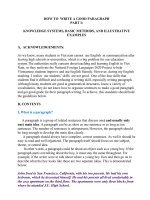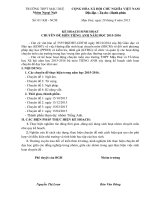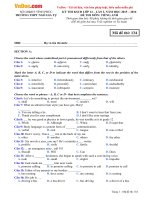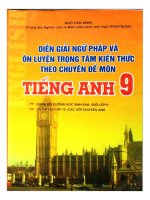Chuyên đề môn Tiếng Anh Helping Students Deal with Reading Comprehension Exercise in Examination
Bạn đang xem bản rút gọn của tài liệu. Xem và tải ngay bản đầy đủ của tài liệu tại đây (152.04 KB, 15 trang )
Vĩnh Phúc Education and Training Department
Helping Students Deal with Reading
Comprehension Exercise in
Examination
Researcher
Group
School
: Nguyen Thanh Thuong
: History, Geography, Foreign Language
: Yen Lac 2 High School.
1
March, 2014
TABLE OF CONTENTS
Content
Page
CHAPTER 1: INTRODUCTION.............................................................4
I. Reason for choosing the research.........................................................4
II. Aim of the study...................................................................................4
III.Scope and objective of the study..........................................................4
CHAPTER 2: CONTENT ........................................................................5
I. Difficulties students may encounter while doing reading
comprehension exercise............................................................................5
.....................................................................................................................
1. Poor vocabulary ....................................................................................5
2. Lack of reading skills ...........................................................................5
II. Suggested solutions..............................................................................5
1. Dealing with unknown words .............................................................5
1.1 No need to understand the whole word.........................................5
1.2. A capital letter or the word is in italic ..............................................6
1.3. The word is explained in the text .....................................................6
1.4. Deduce the meaning of the word from other words .........................6
1.5. Guess the meaning from the general context....................................7
1.6. Recognize a part of word..............................................................7
1.7. Know the type of word......................................................................7
1.8. Practice suggestion- read extensively...........................................8
2
2. Strategies to solve questions and improve poor reading skills..............8
2.1. Main idea questions......................................................................8
2.2. Detailed questions...........................................................................11
3. Other tips while doing reading comprehension exercise....................12
3.1. Read actively....................................................................................12
3.2. Do not run pens under the lines.................................................12
3.3. Read in the phrase..........................................................................12
3.4. Do not utter the word in mind or reading aloud........................13
CHAPTER 3: CONCLUSION ...............................................................14
3
CHAPTER 1: INTRODUCTION
I. REASON FOR CHOOSING THE RESEARCH
As far as we know, English is by far the most widely used among other
thousands of living languages all over the world. It is English that has been used in
various fields such as education, business, commerce, technology, and so on.
Language learning is a complex and long process. Effort is required at every
moment and must be maintained over a long period of time. Students studying
English as a foreign language still encounter a lot of difficulties doing some kinds
of exercises such as vocabulary test, error finding, synonym, antonym and
specially reading comprehension.
While undergoing an exam, most of the students find it very difficult to deal
with reading comprehension. In almost all the exams reading comprehension is one
of the tools to test the knowledge of English. It sounds very difficult as this is the
most time consuming test. We can easily prepare for grammar or error finding
examination but reading comprehension exercises need special attention because
we hardly get any guidelines to prepare them.
In this research the writer would like to work out some main problems
students deal with while doing comprehension exercises and she also would like to
suggest some strategies to help them deal passages easily in limited time.
II. AIMS OF THE RESEARCH.
4
This research aims at working out some main problems students deal with
while doing reading comprehension exercises and suggesting some strategies to
help them deal passages easily and in limited time.
III. SCOPE AND OBJECTS OF THE RESEARCH.
This study focuses on the strategies of doing reading comprehension
exercises in the English examination in order to help students get the best mark.
This study is applied to students in grade twelve to do examination to enter
university.
CHAPTER 2
CONTENT
I. DIFFICULTIES STUDENTS MAY ENCOUNTER WHILE DOING
READING COMPREHENSION EXERCISES
1. Poor vocabulary
Since we are studying English as a foreign language, a big problem is we are
short of vocabulary. While reading a passage what hampers our speed is a term or
word which we are not acquainted of. We waste most of our time in guessing what
could be the meaning of this particular word in a particular passage.
2. Lack of reading skills
If students spend too much time in solving reading comprehension part then
surely it gives them a shortage of time for other questions. If students read slowly
and try to understand every word, they are reading in the wrong way.
II. SUGGESTED SOLUTIONS
1. Dealing with unknown words
This part looks at a key reading skill- the ability to deal with unknown
vocabulary. It’s a vital skill because you are almost certain to find unknown or
unfamiliar words in any reading text. The skill is not necessarily to “know” the
5
words, but to understand enough about them so that you can read and understand
the whole text. Here I suggest several different ways you can do this.
1.1. No need to understand the word at all
The first point to understand is that you do not need to understand every
word in a reading passage in order to get the answer. Indeed, a major reading skill
is the ability to read through words and understand what the general meaning of a
sentence or paragraph is without knowing what every word means.
Students should not spend minutes reading and re-reading a sentence just
because they don’t understand one word. There are questions that are difficult for
native speakers too.
1.2. A capital letter or the word is in italics
If the word starts with a capital letter, it is in all probability a proper name.
In this case, we should waste no time in trying to understand what the word means.
Likewise, if the word is in italics, it is also almost certainly a scientific/technical
term that we do not need to understand.
Example:
The tulip was introduced to Europe in the mid-16th century from the Ottoman
Empire, and became very popular in the United Provinces which are now
the Netherlands. Tulip cultivation in the United Provinces is generally thought to
have started in earnest around 1593 after the Flemish botanist Charles de
l’Écluse had taken up a post at the University of Leiden and established the hortus
academicus.
This is a phrase that we should learn to ignore because it is in italics and is
therefore a technical term.
1.3. The word is explained in the text
Sometimes, we will find that the meaning of an unfamiliar word is given to
us in the text. In this case, what we need to do is keep on reading the sentence and
not stop the moment you find an unfamiliar word. Typically, the way this words is
that we have a phrase in commas immediately after the unfamiliar word:
Example:
6
This lobotomy, an extremely dangerous medical procedure, ultimately cost him his
life.
Here students should understand that “lobotomy” is a medical procedure.
1.4. Deduce the meaning of the word from other words
This is an excellent skill to learn. What you do here is look at other words
which relate to that word and work out what it must mean. These words may be
either synonyms (words with a similar meaning) or opposites.
Example:
The fossils were originally dug up in Kazakhstan by a group of German
archaeologists who were looking for evidence of prehistoric culture. Sometimes
later the bone fragments were taken to Belgium to be exhibited in a museum
specializing in natural history.
Here you can work out the meaning of “fossils” by close synonym “bone
fragments”. All you need to do is read the next sentence and think of meaning.
1.5. Guess the meaning from the general context
This is a more advanced skill. This time you think about the general
meaning of the sentence and make a guess at the probable meaning of that word.
While you are only guessing, it is a skill that does improve with practice: the more
you guess meanings, the more correct you are.
Skin cancer is a common disease. According to Cancer Research UK, around
100,000 cases of non-melanoma were diagnosed in the UK in 2008, and just under
12,000 cases of the more dangerous malignant melanoma were also registered of
which 25% proved fatal.
“Non-melanoma” is a highly technical term. However, if you read the short
paragraph above, it should be obvious that it must be some form of medical term
and probably relates in some way to “skin cancer”. Likewise, you can guess that
“malignant” is in some way related to “dangerous” and “proved fatal” gives you
more evidence of its meaning.
1.6. Recognize a part of the word
This is another advanced skill. What you do here is recognize parts of words
and relate them to other words you do know. Again, this will mean you are
“guessing” and sometimes you may make mistakes, but you should be correct
more often than not.
7
The archaeologists unearthed the bones in Kazakhstan, while looking for evidence
of prehistoric civilizations.
“Unearthed” may be a new word to you, but you can guess here that it has
some connection with “earth” and from the context you should see that it means to
take out of the ground.
1.7. Know the type of word
This is the weakest skill in that it gives you the least amount of information
about the word. However, it can sometimes help to know whether you are looking
at a verb, noun, adverb or adjective.
Example:
In five years time the skills for conducting fundamental science in the UK will not
be here, because everyone will be chasing money to work on the widget the
EPSRC thinks will solve societal problems.
In this text, we have an unusual word “widget”. You can tell the word must
be a noun as it follows “the” and this helps you understand that it must be a thing
of some sort. In fact, all “widget” means is “thing”.
1.8. Practice suggestion – read extensively
Reading extensively means reading for quantity. In practice, this also means
•
•
reading without a dictionary
reading for general meaning
If you do this, you will find yourself reading through unfamiliar words and
making intelligent guesses about what they might mean. If you are uncertain about
this, I can confidently tell you well over 50% of the words you know you will have
learned in this way – passively reading or listening.
2. Strategies to solve questions and improve poor reading skills
There are some types of exercises in the reading comprehension
* Main idea question
* Detailed question
. Stated detail question
. Unstated detail question
. Vocabulary question
8
. Inference question
2.1. Main idea question
This is the question to check the skimming skill of the reader and the main
idea of the passage. Therefore, students should not focus on details or any new
words, they should notice the structure of the passage and key words. A reading
text may be organized as follows:
•
•
•
•
Time order
Cause-Effect
Definition – Example
Comparison-contrast
In order to find out the structure of the text, students need to focus on some signs:
For example:
The time order structure often has words such as at first, then, after that
The Cause-effect structure has connectors such as because, since, as, lead to, as a
result
The key word is often repeated exactly as the one before or it may also be replaced
by a synonym. Students can work out the main idea of the text base on these key
words.
There are some common ways of giving this kind of question.
For example:
What is the topic of the passage? ?
What is the subject of the passage?
What is the main idea of the passage?
What is the author's main point in the passage?
With what is the author primarily concerned?
Which of the following would be the best title?
9
Students should follow some steps to solve this question quickly:
•
•
•
1. Read the first sentence of the passage
2. Try to find out the relationship among the first lines of the passage.
3. Skim the rest sentence to check if the main idea in the first lines is correct with
the rest ones.
4. Reject the wrong answer which is:
Not mentioned in the text
Opposite in meaning with the information given in the text
Too detailed ( Information about time, place)
For example:
Basketball was invented in 1891 by a physical education instructor in Springfield,
Massachusetts, by the name of James Naismith. Because of terrible weather in
winter, his physical education students were indoors rather than outdoors. They
really did not like the idea of boring, repetitive exercises and preferred the
excitement and challenge of a game. Naismith figured out a team sport that could
be played indoors on a gymnasium floor, that involved a lot of running, that kept
all team members involved, and that did not allow the tackling and physical
contact of American* style football.
Question:
What is the topic of this passage?
A. The life of James Naismith
B. The history of sports
C. Physical education and exercise
D. The origin of basketball
The first sentence of the passage mentions “ basketball was invented”, so the main
idea of the passage could be related to basketball. We continue to read the rest
sentence and see some other words related to sport such as “ game, physical
contact, running”.
10
Students should also have a look on the rest answer choice.
A. The life of James Naismith
B. The history of sports
C. Physical education and exercise
D. The origin of basketball
A is not correct because James Naismith is only mentioned as the inventor of
basketball. There is no information about his life or career.
B is not correct because only basketball is mentioned in the text, there is no
information of other sport, it can not be “history of sport”
C is not correct because Physical education is mentioned only once and there is no
supporting idea for it.
So, D is exactly correct.
2.2. Detailed question
This type of question is very common in the test and it accounts for about 50
percent of all the questions.
Detailed question focuses on specified information in each paragraph, such as time,
place, person, thing, cause or effect.
Students can recognize the detailed questions base on following ways of
asking:
-
According to the passage…
It is stated in the passage...
The passage indicates that…
Which of the following is true...?
Example:
Students can find out how fast they read by a simple method. First, they should
count all the words on a page of a book. Then, they read the page as they time
themselves. After finishing reading, they should divide the number of words read
by the number of minutes spent reading.
11
According to the passage, what is the first step in determining your reading
speed?
a. Timing yourself as you read the page of a book
b. Dividing the number of words read by the number of minutes used.
c. Counting the number of words on a page
d. Determining if you need to read faster
Detailed question often follows the order of the reading text. The answer
may be expressed in a different way using synonym or antonym compared to that
in the text.
Example:
Flutes have been around for quite some time, in all sorts of shapes and sizes
and made from a variety of materials. The oldest known flutes are, about 20,000
years old, they were made from hollowed-out bones with holes cut in them. In
addition to bone, older flutes were often constructed from bamboo or hollowed-out
wood.
Today flutes are generally made of metal, and in addition to the holes they
have a complicated system of keys, levers, and pads. The instrument belonging to
well-known flautist James Galway is not just made of any metal, it is made of gold.
Question:
According to the passage, the oldest flutes
A. had holes cut in them
B. were made of metal
C. were made 200,000 years ago
D. had a complicated set of levers and pads
We can find information about “The oldest flutes” in the second sentence of
the passage. “The oldest known flutes are, about 20,000 years old, they were made
from hollowed-out bones with holes cut in them.”
The correct answer should be A
B&D are incorrect because there is no relationship between them and “the
oldest flutes”
C is also incorrect because “The oldest flutes are 20,000 years old”, not
“200,000 years old.”
12
3. Other tips while doing reading comprehension exercise.
3.1. Read actively
It helps students remember the thing and makes the mental pictures
3.2. Do not run pens under the line
Running pens or fingers under the lines will decrease the reading speed
3.3. Read in the phrase
While reading, move your eyes on the whole phrase or as much as you can see at
once. Do not just focus in one word only.
3.4. Do not utter the word in mind or reading aloud
Pronouncing the word or reading loudly can slow down your speed.
13
CHAPTER 3
CONCLUSION
The main purpose of this study is to provide a good way to help students
improve their reading skills as well as give them some tips in doing reading
comprehension exercises in the exam. This study is really helpful if students know
how to apply them correctly in their daily practice and in the examination as well.
Using these techniques can help students overcome the unfamiliar words to
understand the whole text and find out the answer quickly in limited time.
The researcher herself is contented with these techniques and she is applying
it in her classes to help students do the reading comprehension exercises
effectively in a limited time.
In order to get perfect score of this exercise, each student need practice
doing this exercise regularly and continuously enrich their source of vocabulary as
well as grammar structures every day.
14
15









